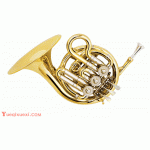原文:
This will pertain to breathing and maintaining an open airway. The diaphragm is called an involuntary muscle. It works without us thinking about it . It works when we are asleep. It can make us sneeze or cough. We can however, exert some control over it. We can hold our breath, take a breath when we want, take a short gasp or a long deep breath. This indicates a measure of control. In as much as trumpet playing is air and breath control then working on this major source of our breath is vital.
The airway must always be open both in inhaling and in playing. One problem is posture. I've seen many experienced players slumped over while jamming. I've seen them with their heads down our their arms against their ribcage. If we give this its proper importance then we see that these things will lead to a closed throat, shallow breaths and poor support. Breath deeply from the bottom of the lungs up.
If the jaw is pushed forward slightly this will cause the throat to be more open than it normally is. Try to move the jaw forward slowly and check if you can feel your throat open up. Think of the effect that can have on your tone. The more forward jaw position will also make your lower lip take on more of the workload. This increases endurance (after you get used to it)。
Another key feature in maintaining an open airway is a pivot. In a nutshell by raising or lowering the bell of your horn while you are playing you can maintain a more open airway and clearer tone. As you play higher and lower notes the air stream will slightly move in the mouthpiece. If we can keep it lined up with the throat hole the sound is better.
The tongue arch has been used for years to speed up the air in order to play higher notes. Most people arch to the point where the sound quality is affected. Instead of arching up to eeee try aaaaa. This is a more open sound yet it still compresses the air slightly. After all the tongue arch cannot give you an extra octave. It is merely used for rapid note movement. The tongue arch is like an elevator it should help you to compress and thereby speed up the air to achieve higher notes.
译文:
这次我们将讨论呼吸和气息流畅通顺的问题。我们腹部的横隔膜被称作“不随意的肌肉”。它的工作不受我们的想法控制。当我们睡觉它也在工作。它还能使我们打喷嚏或咳嗽。但是即便如此,我们也要试着尽力去控制它。我们当然可以做到屏住我们的呼吸,也可以做到随时吸气,既可以少量喘息,又可以做到深吸。我们能做到的这些就告诉了我们对横隔膜的控制方法。既然小号演奏是靠气息和呼吸控制,那么接下来对于我们如何更好的掌握利用这一资源就显得尤为重要了。
在我们吸气和演奏的时候,我们的体内的气息都必须是通畅的。一个重要的问题就是演奏姿态。我曾看到许多有经验的演奏者低着头演奏或者胳膊夹着低头演奏等等。如果我们给出这些姿势一个正确的评价的话,我们所看到的这些姿势将导致我们在演奏中处于一种喉咙封闭,呼吸很浅以及极少的支撑。好的深的呼吸来源于你的肺部底端。
当我们把下颚稍向前移动一点儿,我们会感到喉咙会比正常状态下打开的更多。试着缓慢向前移动你的下颚然后看看你是不是会有喉咙打开的感觉。想着这个方法,它能帮你获得你想要的声音。更靠前的下颚的位置也将给你减轻嘴唇过重的负担,而且还会帮助你提高耐力(当你习惯于这么做以后)。
在保持我们体内气息通畅的方法中还有关键的一点就是你的支点。在你演奏的时候适当的抬高或降低乐器的喇叭口,会保持更通畅的气息和更清晰的音色。随着你演奏更高或更低的音符,进入号嘴的气息也会有微小的变化。当然如果我们能够保持喉咙、气管整齐的接近直线,我们会获得更好的声音。
再有就是拱形状的舌头会加速气息流动,这样为了能演奏更高的音符。好多朋友把舌尖弄成拱的,使声音质量受到影响。一定试着从eeeee的音换成发aaaaa的音(当然要闭着嘴发音)。这样会使声音更开放,而且会把流出的气息变得更细。但是,毕竟这种拱形的舌头不能带给你一个八度音阶,它仅仅适用于快速音符段落。拱形的舌头就像电梯一样可以帮助你压缩气息,从而达到加速气息的目的以帮助演奏更高的音符。
所谓拱形的舌头:你可以用口哨快速吹个大二度音程试一下 看看你的舌头是怎么动的。这个状态就是在吹奏的时候, 舌头在口腔里随着音高的变化,它的位置也在跟着变化。 舌头这个时候跟喉咙共同作用,来控制气流的缓急,对音高变化起着辅助的作用

